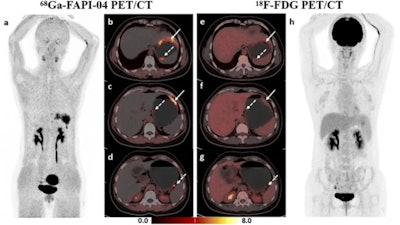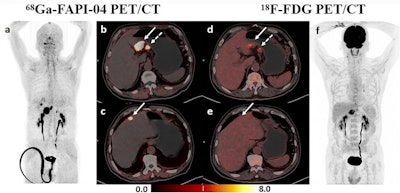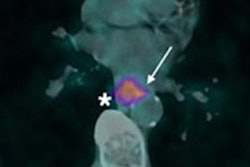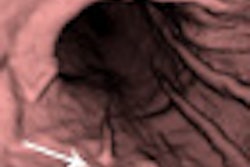
Gallium-68 (Ga-68)-04 and F-18 FDG dual-tracer PET/CT are of equal value for initial evaluation of distant metastases from gastric cancer, but Ga-68 fibroblast-activation protein inhibitor (FAPI)-04 PET/CT shows limited sensitivity in detecting early gastric cancer, a new study has found.
F-18 FDG-PET/CT is used widely in the diagnosis, staging, and preoperative evaluation of gastric cancer, but F-18 FDG-PET/CT has been reported to have a low detection rate for primary gastric cancer, especially in the early stages.
"F-18 FDG-PET/CT imaging for gastric cancer can sometimes be suboptimal, particularly in individuals with non-intestinal-type gastric cancers or individuals with signet ring cell carcinomas (SRCC) or mucinous adenocarcinomas (MAC)," Ying Miao, from the Department of Nuclear Medicine, Ruijin Hospital, Shanghai Jiao Tong University School of Medicine, and colleagues noted in an article posted by European Radiology on 16 December.
Fibroblast activation protein (FAP) is commonly overexpressed in cancer-associated fibroblasts, which are known to be the primary components of stromal cells that contribute up to 90% of the tumor mass, the researchers explained.
 A 44-year-old woman was histopathologically diagnosed with poorly cohesive carcinoma (with partial signet ring cell carcinoma) in the greater curvature of the gastric body and posterior wall of the gastric fundus and had perigastric lymph node metastases. (a-d) Ga-68 FAPI-04 PET/CT imaging. Maximal intensity projection (MIP) image of Ga-68 FAPI-04 PET (a), clear identification of gastric cancer lesions (solid arrow in b, c, and dotted arrow in b) and perigastric metastatic lymph nodes (dotted arrow in c, d). e-h: F-18 FDG-PET/CT imaging. MIP image of F-18 FDG-PET (h), the gastric lesion in the greater curvature of the gastric body (solid arrow in e, f) displayed diffuse mild uptake, the lesions in the posterior wall of the gastric fundus (dotted arrow in e) and perigastric metastatic lymph nodes (dotted arrow in f, g) showed negative uptake. All images courtesy of Ying Miao, Runhua Feng, Zhenggang Zhu, and Biao Li and European Radiology.
A 44-year-old woman was histopathologically diagnosed with poorly cohesive carcinoma (with partial signet ring cell carcinoma) in the greater curvature of the gastric body and posterior wall of the gastric fundus and had perigastric lymph node metastases. (a-d) Ga-68 FAPI-04 PET/CT imaging. Maximal intensity projection (MIP) image of Ga-68 FAPI-04 PET (a), clear identification of gastric cancer lesions (solid arrow in b, c, and dotted arrow in b) and perigastric metastatic lymph nodes (dotted arrow in c, d). e-h: F-18 FDG-PET/CT imaging. MIP image of F-18 FDG-PET (h), the gastric lesion in the greater curvature of the gastric body (solid arrow in e, f) displayed diffuse mild uptake, the lesions in the posterior wall of the gastric fundus (dotted arrow in e) and perigastric metastatic lymph nodes (dotted arrow in f, g) showed negative uptake. All images courtesy of Ying Miao, Runhua Feng, Zhenggang Zhu, and Biao Li and European Radiology.Ga-labeled quinoline-based FAP inhibitor (FAPI) allows for imaging of tumor stroma by targeting FAP. In studies, Ga-68 FAPI-04 PET/CT has outperformed F-18 FDG PET/CT, especially in cancers of unknown primary origin, breast cancer, and several digestive system tumors, including gastric cancer. It may be an alternative to F-18 FDG PET/CT in detecting these tumors, but the number of SRCC patients involved in previous studies on gastric cancer was limited, according to the authors.
Also, elevated FAP expression has been seen during wound healing and matrix remodeling, including chronic inflammation, atherosclerosis, and liver and lung fibrosis. Whether Ga-68 FAPI-04 PET/CT can replace or supplement F-18 FDG PET/CT in the initial evaluation of gastric cancer requires investigation, they stated.
Study logistics
The Shanghai group's main aim was to compare the usefulness of Ga-68 FAPI-04 and F-18 FDG dual-tracer PET/CT for the initial assessment of gastric cancer.
In 62 patients pathologically diagnosed with gastric cancer by gastroscopy biopsy for initial staging, the researchers compared the diagnostic performance of Ga-68 FAPI-04, F-18 FDG, and combined dual-tracer PET/CT. They also measured standardized uptake value (SUV) and tumor-to-background ratio (TBR), and analyzed the factors that influence tracer uptake.
Whole-body PET/CT (from the top of the head to the upper thigh or from the base of the head to the upper thigh with the head scanned separately) was carried out 30-60 minutes after injection of 1.85-2.96 MBq of Ga-68 FAPI-04 per kilogram of body weight (kg/bw) and 60-90 minutes after injection of 3.7-4.44 Mbq of F-18 FDG/kg/bw.
After excluding drug contraindications, 20 mg of hyoscine butylbromide was injected intravenously before scanning, followed by drinking approximately 500 mL of water to achieve gastric distension.
Diagnostic non-contrast-enhanced CT scans were performed using the CARE Dose 4D technique (120 kV, automatic mA-modulation). PET images were obtained in 3D mode and reconstructed in a 440 × 440 matrix size (iteration: 4, subset: 5) using the TrueX + TOF (ultraHD-PET) method. The interval between the two PET/CT scans was within 9 days.
Two nuclear medicine physicians with a combined 17 years of experience in nuclear oncology independently evaluated the PET/CT images.
 A 66-year-old man was histopathologically diagnosed with gastric antrum adenocarcinoma with perigastric lymph node metastases, and a false-positive uptake of Ga-68 FAPI-04 in the liver was proven to be a fibrotic nodule with calcified schistosome egg deposition without heterotypic findings. (a-c) Ga-68 FAPI-04 PET/CT imaging. Maximal intensity projection (MIP) image of Ga-68 FAPI-04 PET (a), clear recognition of gastric cancer lesion (solid arrow in b) and metastatic lymph node (dotted arrow in b), fibrotic nodule with calcified schistosome egg deposition mimicking liver metastasis (c). (d-f) F-18-FDG-PET/CT imaging. MIP image of F-18 FDG-PET (f), lower F-18 FDG-uptake in gastric cancer lesion (solid arrow in d) and the metastatic lymph node (dotted arrow in d) compared with Ga-68 FAPI, liver lesion showed negative uptake (e).
A 66-year-old man was histopathologically diagnosed with gastric antrum adenocarcinoma with perigastric lymph node metastases, and a false-positive uptake of Ga-68 FAPI-04 in the liver was proven to be a fibrotic nodule with calcified schistosome egg deposition without heterotypic findings. (a-c) Ga-68 FAPI-04 PET/CT imaging. Maximal intensity projection (MIP) image of Ga-68 FAPI-04 PET (a), clear recognition of gastric cancer lesion (solid arrow in b) and metastatic lymph node (dotted arrow in b), fibrotic nodule with calcified schistosome egg deposition mimicking liver metastasis (c). (d-f) F-18-FDG-PET/CT imaging. MIP image of F-18 FDG-PET (f), lower F-18 FDG-uptake in gastric cancer lesion (solid arrow in d) and the metastatic lymph node (dotted arrow in d) compared with Ga-68 FAPI, liver lesion showed negative uptake (e).The authors reported that Ga-68 FAPI-04 PET/CT detected more primary lesions (90.3% vs. 77.4%, p = 0.008) and peritoneal metastases (91.7% vs. 41.7%, p = 0.031) and demonstrated higher SUVmax and TBR values (p < 0.001) of primary lesions compared to F-18 FDG PET/CT.
Dual-tracer PET/CT significantly improved the diagnostic sensitivity for the detection of distant metastases, compared with stand-alone F-18 FDG (97.1% vs. 73.5%, p = 0.008) or Ga-68 FAPI-04 (97.1% vs. 76.5%, p = 0.016) PET/CT.
Treatment strategies were then changed in nine patients following Ga-68 FAPI-04 and F-18 FDG dual-tracer PET/CT. Nevertheless, Ga-68 FAPI-04 uptake was primarily influenced by the size and invasion depth of the tumor. Both Ga-68 FAPI-04 and F-18 FDG PET/CT showed limited sensitivity for detecting early gastric cancer (37.5% vs. 25%, p > 0.05).
These findings require further validation in a larger multicenter prospective study, Miao and colleagues concluded.



















